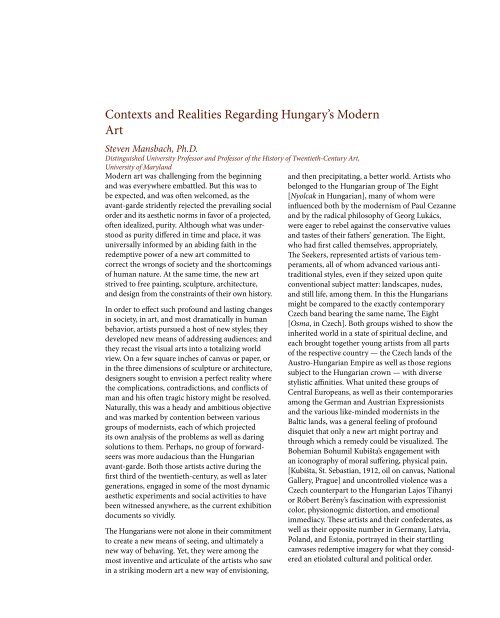The Art of Hungary
1bkCZCNNN
1bkCZCNNN
Create successful ePaper yourself
Turn your PDF publications into a flip-book with our unique Google optimized e-Paper software.
Contexts and Realities Regarding <strong>Hungary</strong>’s Modern<br />
<strong>Art</strong><br />
Steven Mansbach, Ph.D.<br />
Distinguished University Pr<strong>of</strong>essor and Pr<strong>of</strong>essor <strong>of</strong> the History <strong>of</strong> Twentieth-Century <strong>Art</strong>,<br />
University <strong>of</strong> Maryland<br />
Modern art was challenging from the beginning<br />
and was everywhere embattled. But this was to<br />
be expected, and was <strong>of</strong>ten welcomed, as the<br />
avant-garde stridently rejected the prevailing social<br />
order and its aesthetic norms in favor <strong>of</strong> a projected,<br />
<strong>of</strong>ten idealized, purity. Although what was understood<br />
as purity differed in time and place, it was<br />
universally informed by an abiding faith in the<br />
redemptive power <strong>of</strong> a new art committed to<br />
correct the wrongs <strong>of</strong> society and the shortcomings<br />
<strong>of</strong> human nature. At the same time, the new art<br />
strived to free painting, sculpture, architecture,<br />
and design from the constraints <strong>of</strong> their own history.<br />
In order to effect such pr<strong>of</strong>ound and lasting changes<br />
in society, in art, and most dramatically in human<br />
behavior, artists pursued a host <strong>of</strong> new styles; they<br />
developed new means <strong>of</strong> addressing audiences; and<br />
they recast the visual arts into a totalizing world<br />
view. On a few square inches <strong>of</strong> canvas or paper, or<br />
in the three dimensions <strong>of</strong> sculpture or architecture,<br />
designers sought to envision a perfect reality where<br />
the complications, contradictions, and conflicts <strong>of</strong><br />
man and his <strong>of</strong>ten tragic history might be resolved.<br />
Naturally, this was a heady and ambitious objective<br />
and was marked by contention between various<br />
groups <strong>of</strong> modernists, each <strong>of</strong> which projected<br />
its own analysis <strong>of</strong> the problems as well as daring<br />
solutions to them. Perhaps, no group <strong>of</strong> forwardseers<br />
was more audacious than the Hungarian<br />
avant-garde. Both those artists active during the<br />
first third <strong>of</strong> the twentieth-century, as well as later<br />
generations, engaged in some <strong>of</strong> the most dynamic<br />
aesthetic experiments and social activities to have<br />
been witnessed anywhere, as the current exhibition<br />
documents so vividly.<br />
<strong>The</strong> Hungarians were not alone in their commitment<br />
to create a new means <strong>of</strong> seeing, and ultimately a<br />
new way <strong>of</strong> behaving. Yet, they were among the<br />
most inventive and articulate <strong>of</strong> the artists who saw<br />
in a striking modern art a new way <strong>of</strong> envisioning,<br />
and then precipitating, a better world. <strong>Art</strong>ists who<br />
belonged to the Hungarian group <strong>of</strong> <strong>The</strong> Eight<br />
[Nyolcak in Hungarian], many <strong>of</strong> whom were<br />
influenced both by the modernism <strong>of</strong> Paul Cezanne<br />
and by the radical philosophy <strong>of</strong> Georg Lukács,<br />
were eager to rebel against the conservative values<br />
and tastes <strong>of</strong> their fathers’ generation. <strong>The</strong> Eight,<br />
who had first called themselves, appropriately,<br />
<strong>The</strong> Seekers, represented artists <strong>of</strong> various temperaments,<br />
all <strong>of</strong> whom advanced various antitraditional<br />
styles, even if they seized upon quite<br />
conventional subject matter: landscapes, nudes,<br />
and still life, among them. In this the Hungarians<br />
might be compared to the exactly contemporary<br />
Czech band bearing the same name, <strong>The</strong> Eight<br />
[Osma, in Czech]. Both groups wished to show the<br />
inherited world in a state <strong>of</strong> spiritual decline, and<br />
each brought together young artists from all parts<br />
<strong>of</strong> the respective country — the Czech lands <strong>of</strong> the<br />
Austro-Hungarian Empire as well as those regions<br />
subject to the Hungarian crown — with diverse<br />
stylistic affinities. What united these groups <strong>of</strong><br />
Central Europeans, as well as their contemporaries<br />
among the German and Austrian Expressionists<br />
and the various like-minded modernists in the<br />
Baltic lands, was a general feeling <strong>of</strong> pr<strong>of</strong>ound<br />
disquiet that only a new art might portray and<br />
through which a remedy could be visualized. <strong>The</strong><br />
Bohemian Bohumil Kubišta’s engagement with<br />
an iconography <strong>of</strong> moral suffering, physical pain,<br />
[Kubišta, St. Sebastian, 1912, oil on canvas, National<br />
Gallery, Prague] and uncontrolled violence was a<br />
Czech counterpart to the Hungarian Lajos Tihanyi<br />
or Róbert Berény’s fascination with expressionist<br />
color, physionogmic distortion, and emotional<br />
immediacy. <strong>The</strong>se artists and their confederates, as<br />
well as their opposite number in Germany, Latvia,<br />
Poland, and Estonia, portrayed in their startling<br />
canvases redemptive imagery for what they considered<br />
an etiolated cultural and political order.


